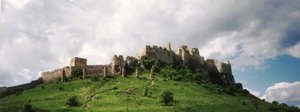|
Spišská Nová Ves and the Spiš region
Spišská Nová Ves, with 40,000 residents, is one of
the main cities in the Spiš region of Slovakia. Spiš is
located just south/southwest of the majestic Tatra Mountains, which
form the border between Slovakia and Poland. The snow capped peaks of
the Tatras can be seen from the central square of the city.
The earliest
record of human activity in the Spiš region goes back to
Neolithic times, and archaeological finds of settlements around the
city of Spišská Nová Ves have been dated to the
8th century. The first written mention of the city has been found on a
document dated from 1268, around the time when the Slovak settlement of
Iglov combined with the Carpathian German settlement of Neudorf to
become a new entity. In fact, "Nová Ves" translated into English
means "New City". Many of the towns in the Spiš region had both
Germanic and Slovak influences, and until World War II, the area had a
large German-speaking population.
In the
mid-1200s, the Spiš region was continually infused with new
arrivals, many specializing in the mining trade. Spiš began to
function as an semi-autonomous region, gaining self-governmnet
privileges after assisting King Charles I to defeat the Kingdom of
Hungary in 1312. Spiš retained much of its independence until
many of the towns in the region were pawned to the Kingdom of Poland in
1412. This was done because the King of Luxembourg, who controlled the
Spiš region until the pawning, needed some finances for a war
with Venice. The Spiš region would remain under the control of
Poland until 1772 (about 360 years), when the Kingdom of Hungary
annexed the region.
The Spiš
region remained part of the Austria-Hungary empire until 1918 after
World War I, at which point it became a component of the newly formed
country of Czechoslovakia. Between 1940 and 1945, after Hitler's
annexation of the Czech lands, Spiš was a region in the
independent country of Slovakia. But after World War II, the Czech
Republic and the Slovak Republic merged to form Czechoslovakia again,
which soon fell under the sphere of Communism and Russian influence for
the next forty-five years.
In 1989,
communist rule in Czechoslovakia ended. Then on January of 1993, in
what many historians call the "velvet revolution", Czechoslovakia was
dissolved, forming the Czech Republic and the Slovak Republic.
Slovakia, also known as the Slovak Republic, became a member of the
European Union in May of 2004.
Spišská
Nová Ves is surrounded by beautiful natural landscapes and
historical structures. The city is in close proximity to the Tatra
Mountains and a national park of Slovakia call the Slovensky Raj, or
"Slovak Paradise". Below is a photo of Spiš Castle, just a few
kilometers away from the city center. Spiš Castle is the largest
castle in Central Europe.

The mayor of Spišská Nová Ves is Jan Volny, and the website of the city can be found at: www.spisskanovaves.eu
revised 21-Aug-2012
|

